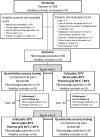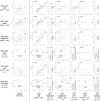Strong and aversive cold processing and pain facilitation in fibromyalgia patients relates to augmented thermal grill illusion
- PMID: 37749154
- PMCID: PMC10520026
- DOI: 10.1038/s41598-023-42288-7
Strong and aversive cold processing and pain facilitation in fibromyalgia patients relates to augmented thermal grill illusion
Abstract
The thermal grill illusion (TGI) is assumed to result from crosstalk between the thermoreceptive and nociceptive pathways. To elucidate this further, we compared 40 female fibromyalgia patients to 20 healthy women in an exploratory cross-sectional study. Sensations (cold, warm/heat, unpleasantness, pain and burning) evoked by 20 °C, 40 °C and alternating 20 °C/40 °C (TGI) and somatosensory profiles according to standardized quantitative sensory testing (QST) were assessed on the palm of the dominant hand. Compared to healthy controls, fibromyalgia patients reported stronger thermal grill-evoked cold, warm, unpleasantness and pain as well as stronger and more aversive 20 °C- and 40 °C-evoked sensations. They showed a loss in warm, mechanical and vibration detection, a gain in thermal pain thresholds and higher temporal summation (TS). Among QST parameters higher TS in fibromyalgia patients was most consistently associated with an augmented TGI. Independently, an increased TGI was linked to cold (20 °C) but less to warm (40 °C) perception. In fibromyalgia patients all thermal grill-evoked sensations were positively related to a higher 20 °C-evoked cold sensation and/or 20 °C-evoked unpleasantness. In conclusion, the TGI appears to be driven mainly by the cold-input. Aversive cold processing and central pain facilitation in fibromyalgia patients seem to independently augment the activation of the pain pathway.
© 2023. Springer Nature Limited.
Conflict of interest statement
All authors declare no competing interests.
Figures




Similar articles
-
Sex differences in thermal detection and thermal pain threshold and the thermal grill illusion: a psychophysical study in young volunteers.Biol Sex Differ. 2017 Sep 1;8(1):29. doi: 10.1186/s13293-017-0147-5. Biol Sex Differ. 2017. PMID: 28859684 Free PMC article.
-
It is one or the other: No overlap between healthy individuals perceiving thermal grill illusion or paradoxical heat sensation.Neurosci Lett. 2023 Apr 1;802:137169. doi: 10.1016/j.neulet.2023.137169. Epub 2023 Mar 8. Neurosci Lett. 2023. PMID: 36898653
-
Conditioned pain modulation dampens the thermal grill illusion.Eur J Pain. 2017 Oct;21(9):1591-1601. doi: 10.1002/ejp.1060. Epub 2017 Jun 2. Eur J Pain. 2017. PMID: 28573748 Clinical Trial.
-
A Review on Various Topics on the Thermal Grill Illusion.J Clin Med. 2021 Aug 16;10(16):3597. doi: 10.3390/jcm10163597. J Clin Med. 2021. PMID: 34441893 Free PMC article. Review.
-
Beyond labeled lines: A population coding account of the thermal grill illusion.Neurosci Biobehav Rev. 2020 Jan;108:472-479. doi: 10.1016/j.neubiorev.2019.11.017. Epub 2019 Nov 26. Neurosci Biobehav Rev. 2020. PMID: 31783059 Review.
Cited by
-
Quantitative Sensory Testing in Fibromyalgia Syndrome: A Scoping Review.Biomedicines. 2025 Apr 17;13(4):988. doi: 10.3390/biomedicines13040988. Biomedicines. 2025. PMID: 40299678 Free PMC article. Review.
-
Deciphering nociplastic pain: clinical features, risk factors and potential mechanisms.Nat Rev Neurol. 2024 Jun;20(6):347-363. doi: 10.1038/s41582-024-00966-8. Epub 2024 May 16. Nat Rev Neurol. 2024. PMID: 38755449 Review.
References
-
- Alrutz S. On the temperature senses: II. The sensation 'hot'. Mind. 1898;7:141–144.
-
- Adam F, Alfonsi P, Kern D, Bouhassira D. Relationships between the paradoxical painful and nonpainful sensations induced by a thermal grill. Pain. 2014;155:2612–2617. - PubMed
-
- Leung AY, Wallace MS, Schulteis G, Yaksh TL. Qualitative and quantitative characterization of the thermal grill. Pain. 2005;116:26–32. - PubMed
-
- Hunter J, Dranga R, van Wyk M, Dostrovsky JO. Unique influence of stimulus duration and stimulation site (glabrous vs. hairy skin) on the thermal grill-induced percept. Eur. J. Pain. 2015;19:202–215. - PubMed
-
- Bach P, Becker S, Kleinböhl D, Hölzl R. The thermal grill illusion and what is painful about it. Neurosci. Lett. 2011;505:31–35. - PubMed
Publication types
MeSH terms
Associated data
LinkOut - more resources
Full Text Sources
Medical

